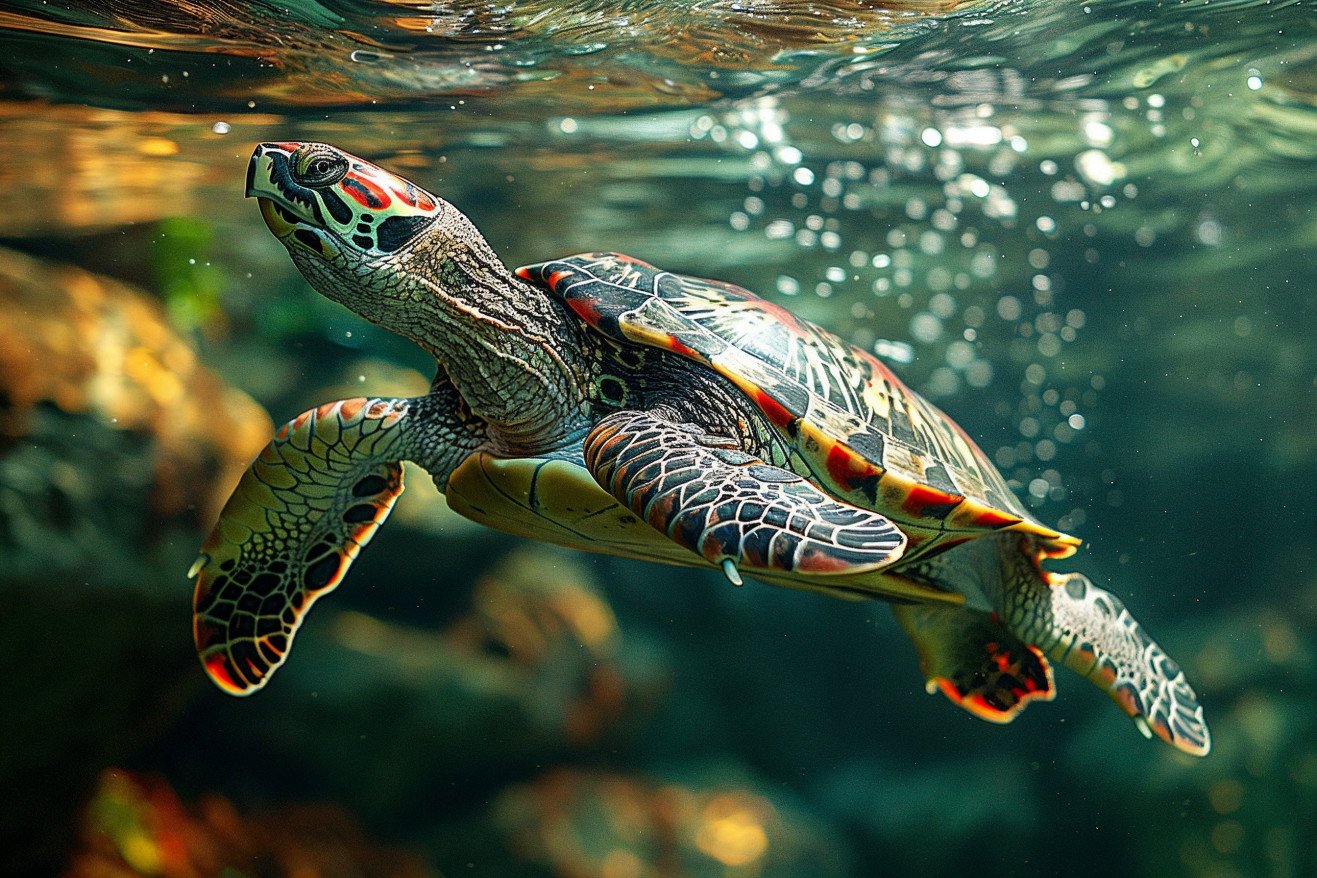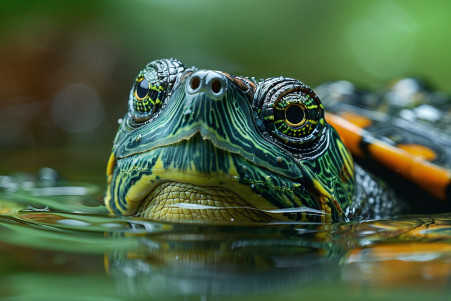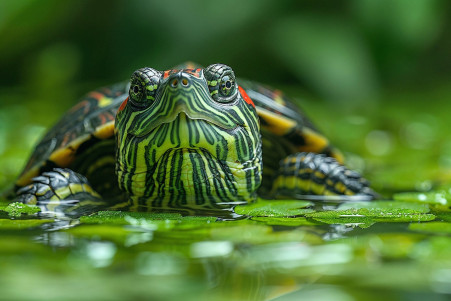How Do Turtles Breathe Underwater? Evolutionary Adaptations
9 April 2024 • Updated 8 April 2024

Turtles are reptiles, and as such, they are air-breathing animals. However, they have evolved several special features that enable them to hold their breath and stay underwater for long periods of time. Turtles do not breathe underwater, and they do not have gills. Instead, they breathe through their mouths, which have structures that extract oxygen from the water when they are closed.
In this article, we will explore the biological adaptations that make turtles' ability to breathe underwater possible. Through an exploration of the findings of scientific research on turtle biology, including anatomy, physiology, and behavior, you will learn about the special features that have enabled these animals to be successful in both aquatic and terrestrial habitats. This knowledge will give you a greater understanding of the power of evolution and the amazing diversity of life on Earth.
Can turtles breathe underwater?
Anatomical and Physiological Adaptations for Underwater Breathing
Turtles have evolved remarkable anatomical and physiological traits that enable their impressive breath-holding abilities underwater. A key adaptation is their slow metabolic rate, which reduces their oxygen needs during dives. This allows sea turtles like the green turtle to stay submerged for up to 5 hours with their heart rate slowing to conserve oxygen.
Another crucial adaptation is their high concentrations of oxygen-carrying hemoglobin in the blood and myoglobin in the muscles, as highlighted for the leatherback turtle. This allows turtles to store large amounts of oxygen throughout their bodies for use during dives. Their large lung surface areas further facilitate efficient gas exchange and oxygen intake with each breath before submerging, according to research on chelonian sea turtles.
Turtles' streamlined, hydrodynamic bodies and flipper-like limbs enable low-resistance swimming and movement underwater to conserve oxygen. Their ability to close their nostrils prevents water entry into their respiratory systems. Moreover, sea turtles can collapse their lungs at depths of 80-160m to avoid decompression issues during long, deep dives. This remarkable anatomical adaptation, combined with their physiological "diving reflex" that slows the heart rate and oxygen consumption, allows turtles to thrive in aquatic environments for extended periods. Their breath-holding capabilities are critical for activities like foraging, migration and avoiding predators.
How Long Can Turtles Hold Their Breath?
Sea turtles can hold their breath for 4-7 minutes before coming up for air, says the Olive Ridley Project. However, they can stay underwater for several hours when they're resting or sleeping by conserving oxygen, according to Pets on Mom.com.
Leatherback sea turtles are especially impressive, with dives that can reach depths of over 1,000 meters and last up to 5 hours, according to Scientific American. Meanwhile, the National Park Service explains that freshwater turtles in temperate climates can even hibernate underwater for months by absorbing dissolved oxygen.
All of the sources agree that a number of factors including the turtle's species, water temperature, and whether it's active or at rest affect how long turtles can stay underwater. However, it's clear that turtles' ability to hold their breath for long periods of time has helped them adapt to a variety of aquatic and terrestrial environments and is an important part of the evolutionary story that's allowed them to thrive.
Diving and Hibernation Techniques
According to All Turtles, many semi-aquatic turtles, including mud turtles, musk turtles, and painted turtles, sleep underwater for 4 to 7 hours at a time, surfacing to breathe intermittently. Some turtles, such as the painted turtle and Japanese pond turtle, can hibernate underwater for months at a time by lowering their metabolism and using cloacal respiration, which enables them to breathe through their cloaca.
During hibernation, turtles take in oxygen through the blood vessels in their cloaca, enabling them to survive without surfacing. According to The Spruce Pets, this ectothermic, or "cold-blooded", state allows turtles to reduce their body temperature, heart rate, and respiratory rate, conserving energy.
In captivity, it's important to maintain the right environmental conditions to ensure that turtles can sleep and hibernate properly. As The Spruce Pets notes, this includes providing the right lighting, hiding spots, and temperature gradients. Meanwhile, light and noise pollution from human activities can interfere with sea turtles' ability to sleep, potentially endangering their lives, according to the Discover Creatures article.
Cloacal Respiration: Breathing Through the Butt
In addition to cutaneous respiration, turtles can also breathe through their cloacas, or rear ends, in a process known as cloacal respiration. Like cutaneous respiration, cloacal respiration is well-documented in amphibians and reptiles and enables them to survive in oxygen-poor habitats.
In fact, some turtle species, such as the Fitzroy River turtle, depend on cloacal respiration to survive long periods underwater. However, because cloacal respiration is less efficient than lung-based respiration, it's only possible for turtles because their oxygen demands decrease when they hibernate and their metabolism slows to the point that it's in line with their cold-blooded ectothermic nature.
During cloacal respiration, turtles suck water in through their cloacal openings and into sacs called bursae, which are lined with papillae that enable gas exchange, according to Live Science. Oxygen in the water diffuses across the papillae and into the turtle's blood, enabling them to breathe underwater for months at a time.
This adaptation enables turtles to live in environments where their access to air-breathing is limited, such as fast-moving rivers and frozen ponds. Still, cloacal respiration is much less efficient than lung-based respiration, which is why it's a secondary form of respiration for turtles. This also shows how turtles have evolved to adapt to their environment.
Coping With Extreme Cold: Thermoregulation and Overwintering
Because turtles are ectotherms, their body temperature is the same as their environment. When turtles are in cold water, their metabolism and oxygen consumption drop, enabling them to survive with very little oxygen, according to the National Park Service.
Sea turtles rely on basking and migrating to warmer waters to control their body temperature, according to NOAA Fisheries, although leatherbacks have the ability to insulate themselves and make physiological adjustments that allow them to forage in cold waters, as reported by obxforever.org.
Meanwhile, freshwater turtles release carbonate buffers from their shells to counteract the lactic acid that builds up when they overwinter, according to the NCPR News article. This adaptation enables them to live in cold, low-oxygen conditions that would be lethal for many other animals.
Amazing Examples of Evolution
Turtles have evolved a number of adaptations that allow them to conserve oxygen and stay underwater for long periods of time. One of the most important of these adaptations is the ability to slow their metabolism while they are underwater. This allows them to conserve oxygen and stay underwater for long periods of time, according to Smore Science Magazine.
In addition, some turtles have evolved a special way to breathe while they are underwater. Instead of breathing through their mouth and nose, these turtles breathe through their cloaca, or rear end. Water moves in and out of the cloaca, and blood vessels in the cloaca extract oxygen from the water. This cloacal respiration is an amazing adaptation that allows certain turtles to stay underwater for long periods of time without having to surface to breathe, according to the same source.
Sea turtles have lungs that are located under the shell on their back. They breathe by moving muscles that are attached to their shoulders and hips, which allows them to move air in and out of their lungs. In fact, when sea turtles are on land, you can sometimes see them moving their shoulders. This is because moving their shoulders helps them breathe by moving air into their lungs, according to Smore Science Magazine.
Even baby turtles have evolved adaptations that allow them to breathe. For example, they can breathe while they are still in their eggs, which is no easy feat. They have a temporary egg tooth called a caruncle that allows them to break their shell and breathe at the same time. Baby turtles can breathe while they are still in their eggs because they have evolved a special way of extracting oxygen from the air, according to the same source.
Conclusion: Understanding Turtle Adaptations for Aquatic Respiration
Turtles have evolved a number of adaptations that allow them to thrive in both aquatic and terrestrial habitats. Their ability to hold their breath and stay underwater for long periods of time is a testament to the success of these adaptations. Understanding these adaptations can help us better appreciate the diversity and adaptability of life on Earth.
In addition, future studies of turtle biology can help us better understand the processes of evolution and conservation. The adaptations that allow turtles to breathe underwater are just one example of the many wonders of the natural world.


